There has been a bit of blog silence on it for the last few months, but I have been plugging away on the 1370ish dress, but there has been an awful lot of effort on it that doesn’t look like anything, because it was just unpicking and re-doing.
I got it all sewn together, did an initial fit, and it just didn’t feel quite right, which prompted a LOT more research. Based on the research, I decided that lining 14th century gowns with linen is almost certainly not accurate, and gives a fit that doesn’t match the fits shown on effigies of the period.
This is what the dress looked like with a linen lining:
It looks really good, but it’s very constricting. It just didn’t feel right.
So I sucked it up and unpicked the lining. And all my gores. And then I re-sewed the entire gown without a lining, and with the gores placed almost at my waist.
As soon as I tried on gown 2.0 I knew two things.
First, the fit is SO much better without a lining. It feels much more correct. The gown is much easier to wear, much easier to move in, and provides support without constriction. I can move and pose in exactly the stances shown in illuminations and effigy, and it feels comfortable, whereas it felt awkward and as if I was fighting the dress when it had a lining.
It’s not just that I’m small busted. Even a MUCH bustier friend who tried on the dress was impressed by how much support the dress supplied with a snug fit and slight give from the wool.
Even though it was extra work, I’m very glad I tried the lining, because I was able to compare it to a dress without the lining and really understand the difference in fit.
The second thing I found from version 2.0 isn’t so good. I DO NOT like the higher gores. They ‘poof’ out way too much over my hips, and rub against the top of my hipbone, and basically don’t match the more androgynous 1360s-70s silhouette I am going for.
They haven’t, of course, had time to really hang into place, and they would benefit from a really good pressing, both of which would would help. If I were doing 1390s the silhouette would be more appropriate, but as they are I don’t like them.
So….more unpicking.
Yay.
(yes, I know I like unpicking, or at least don’t dislike it, but not heavy cotton thread (yes, inaccurate but this was always a test dress) on fulled wool in the middle of winter when the pressure of the quick-unpick on my finger gives me a big chillblain lump where it rubs as I hold it is not fun!).
I’ve got one other tiny thing I wish I could change, but can’t. I’m not in love with the neckline. I lowered it a couple of cm from the first fitting, and widened it quite a lot, and I wish I’d only widened it – it’s a little lower than I would like.
I’ve ended up with lady in blue instead of lady in red after all:

Guillaume de Machaut watching the disappointed lover. РThe Judgement of the King of Navarre. Mątre Policratique . 1380-1395
I may try to widen the neckline as much more as I possibly can. The good thing about a low, wide, neckline, is that I can wear every possible layer over it, and their necklines will fit, so that’s a bonus!
In addition to tons of unpicking and re-sewing, I finished and faced the front edge:
The sewing is done with a combination of silk and linen thread, and all of the lacing holes are worked in linen thread.
There are 32 hand-worked lacing holes going down my front, placed one inch apart, and offset so that the dress laces in a spiral.
Look how beautifully they match Katherine’s lacing:
Only mine slant the other way! I hope that isn’t bad or not-period-accurate. I didn’t even think about it when I started the lacing holes, just picked one side, started, and assumed the other could be offset!
Question to think about: was their a medieval etiquette around which way lacing slants…?
To lace my gown, I’m using a linen cord for now, until I find/make something better.
To make lacing it easier, I use a bodkin.
There is a lot of evidence that bodkins were in use by the 14th century, and they certainly help with the lacing! I’m particularly pleased with this one, as it looks more like earlier bodkins. Maybe I should engrave it!
Still to do: finish the neckline; let out the side seams the tiniest bit, as the lacing is struggling slightly across the bust; pattern, sew, and set in the sleeves, work endless amounts of sleeve buttonholes, sew on the buttons, and hem. And press, press, press!
Oh, and remove a couple of kilos of Felicity hair, because it attracts it like a magnet!
Plus I actually have something to wear this too? Yes! A historical evening near the end of August! Exciting!
But that does mean I have to get it done by a certain date, and have a headdress to wear it with (though it this case, I think the most glamourous & high status circlet-&-fancy braided hairdo (and maybe even, gasp, a silk veil (or, you know, just appropriating the not-historical silk fichu I use for 18th century)) will be more appropriate than the period accurate linen veils I’ll be making later.)! 😉

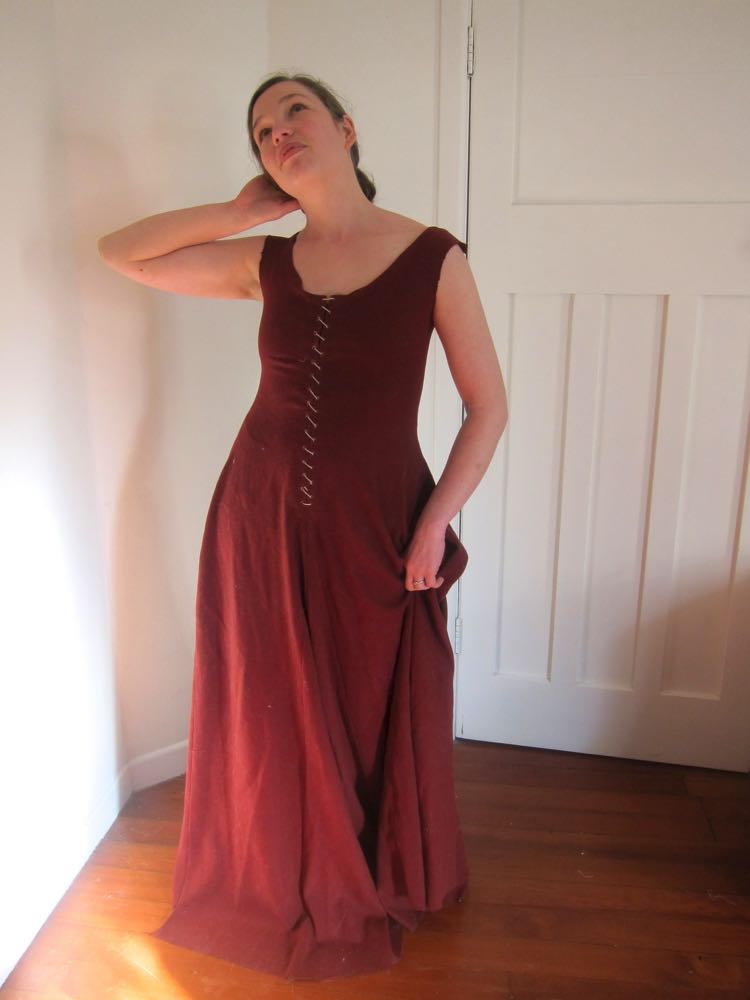
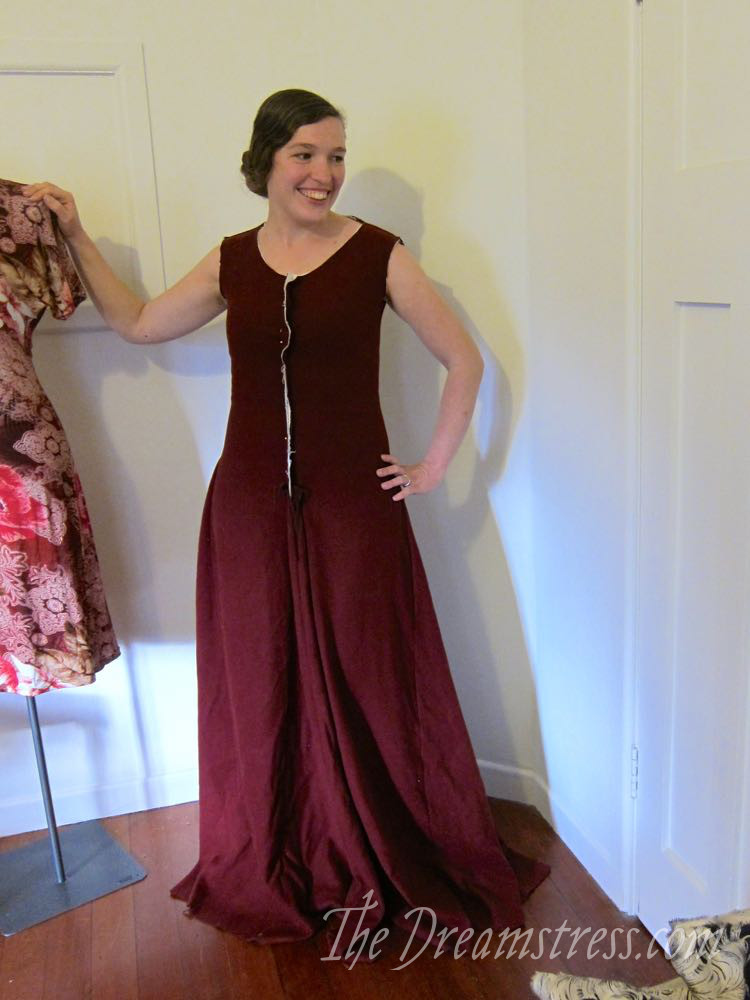
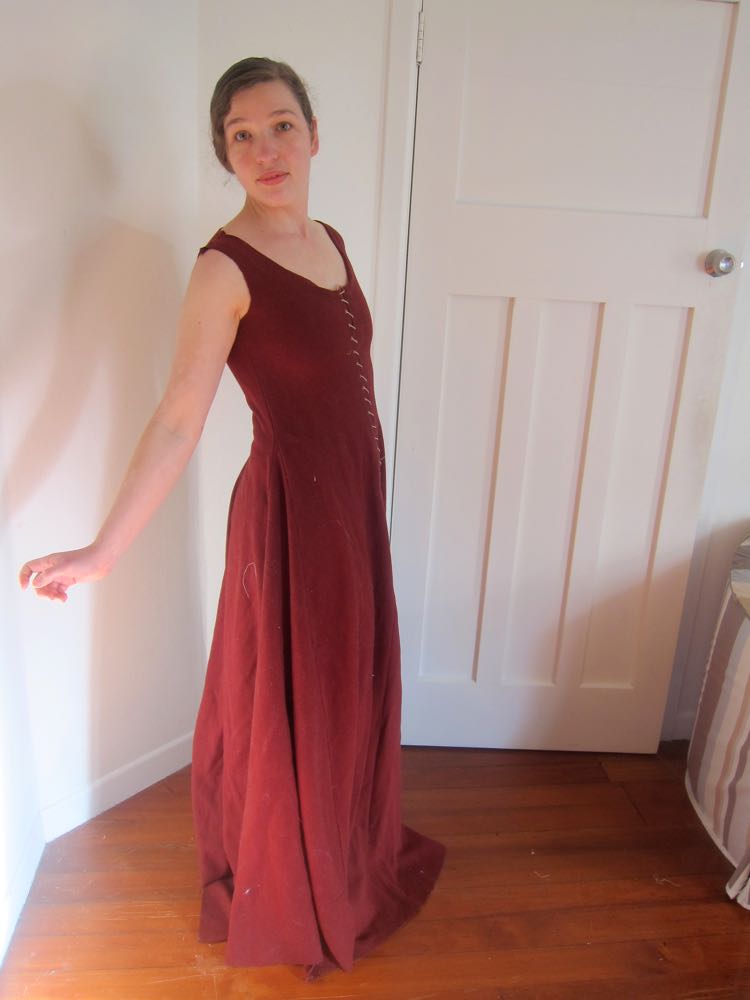
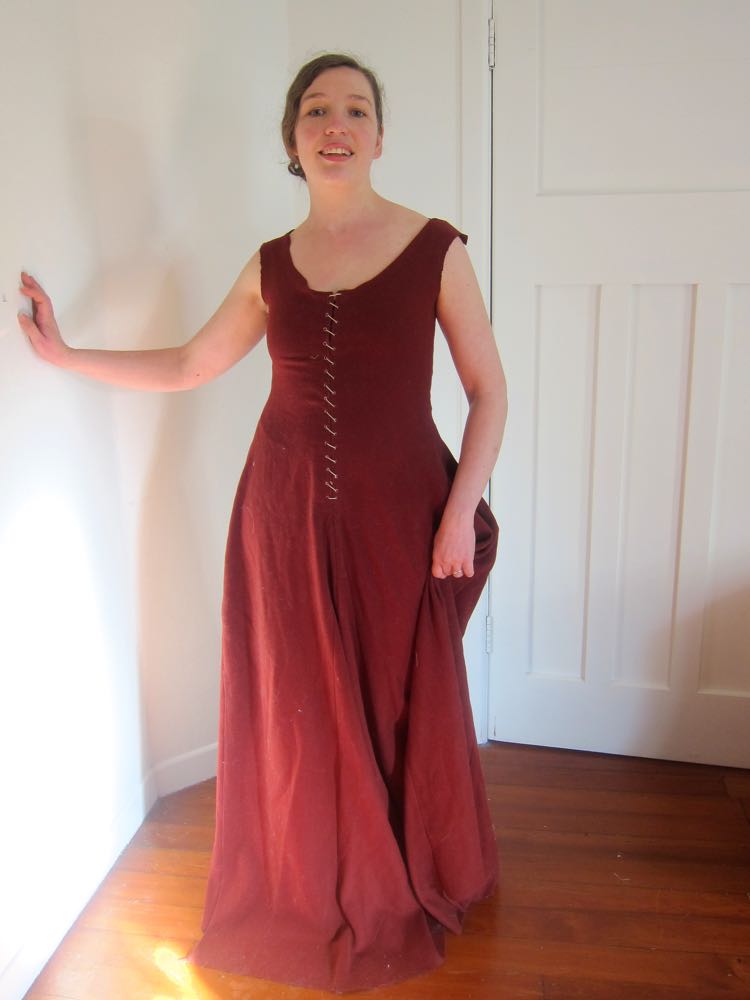
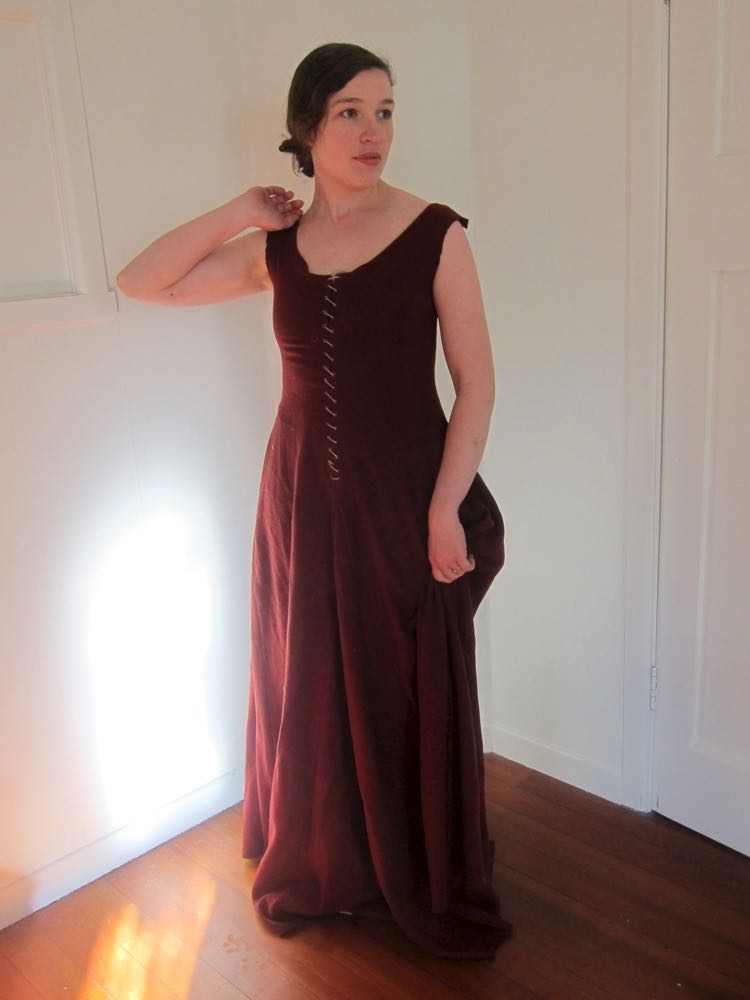
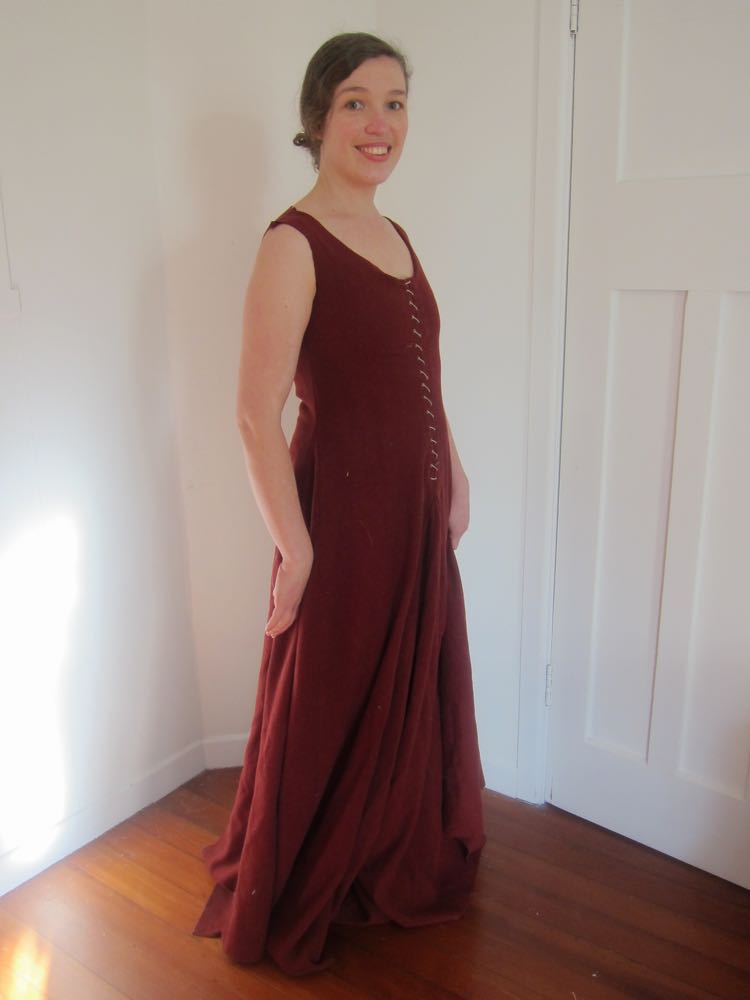
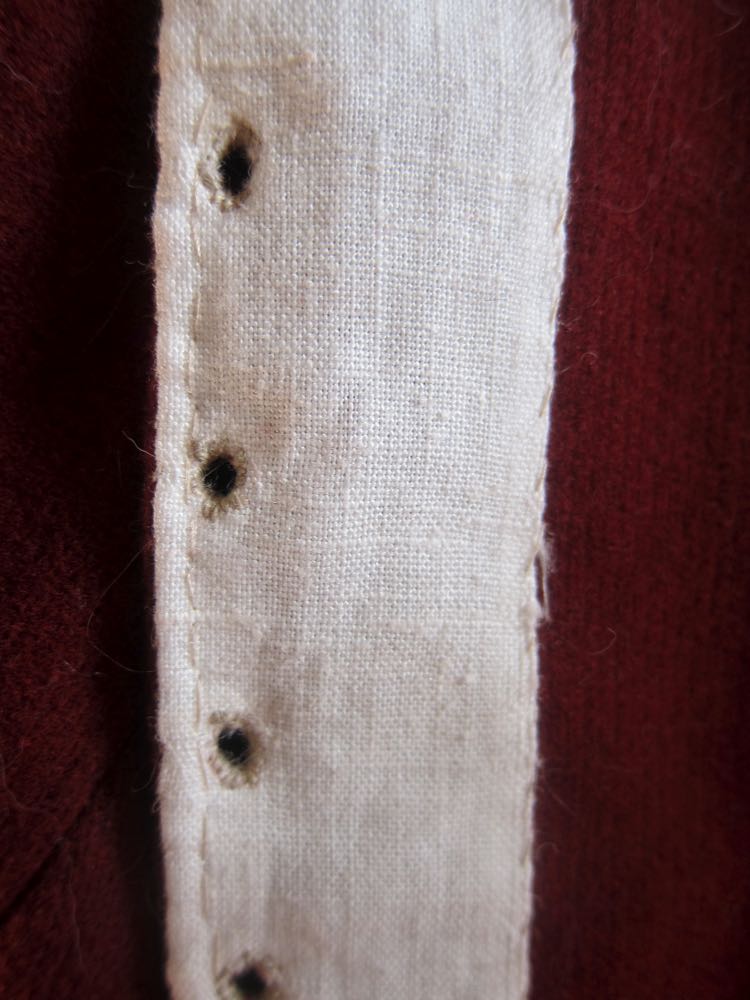
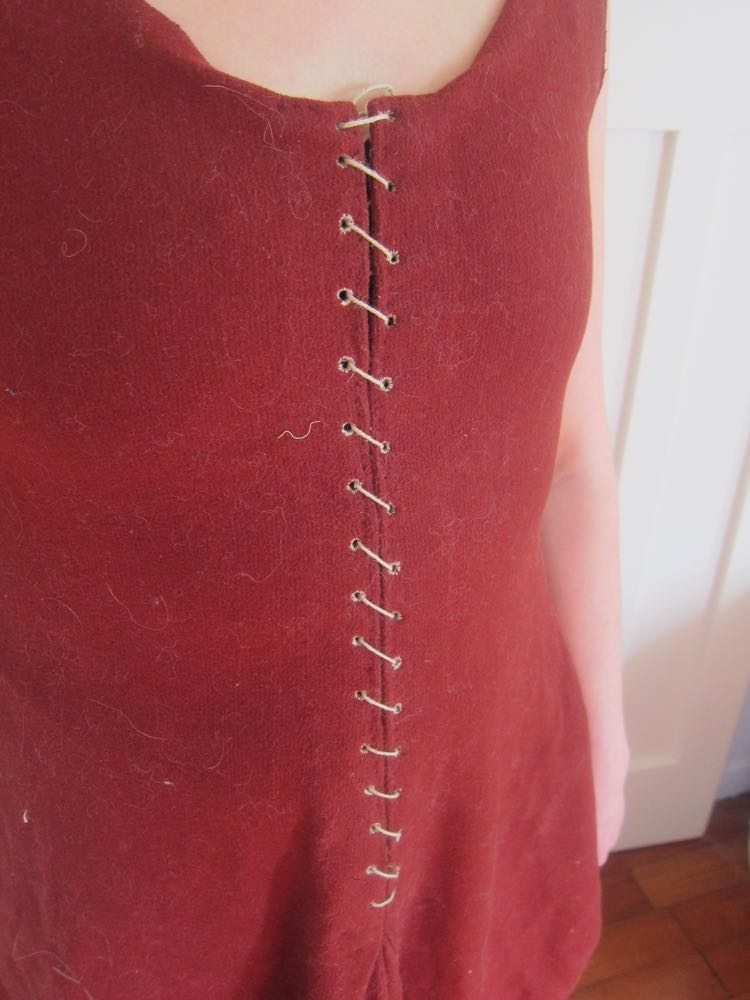
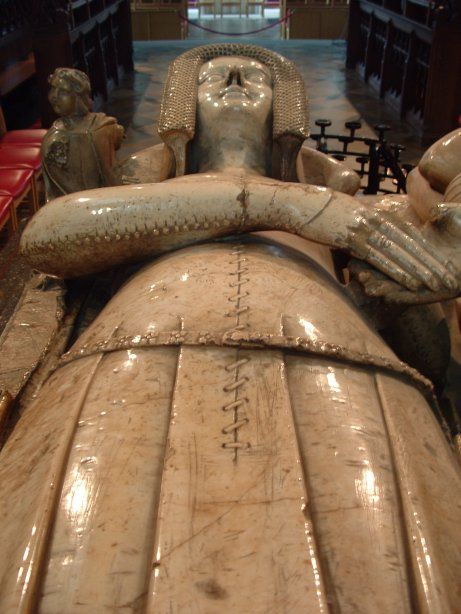
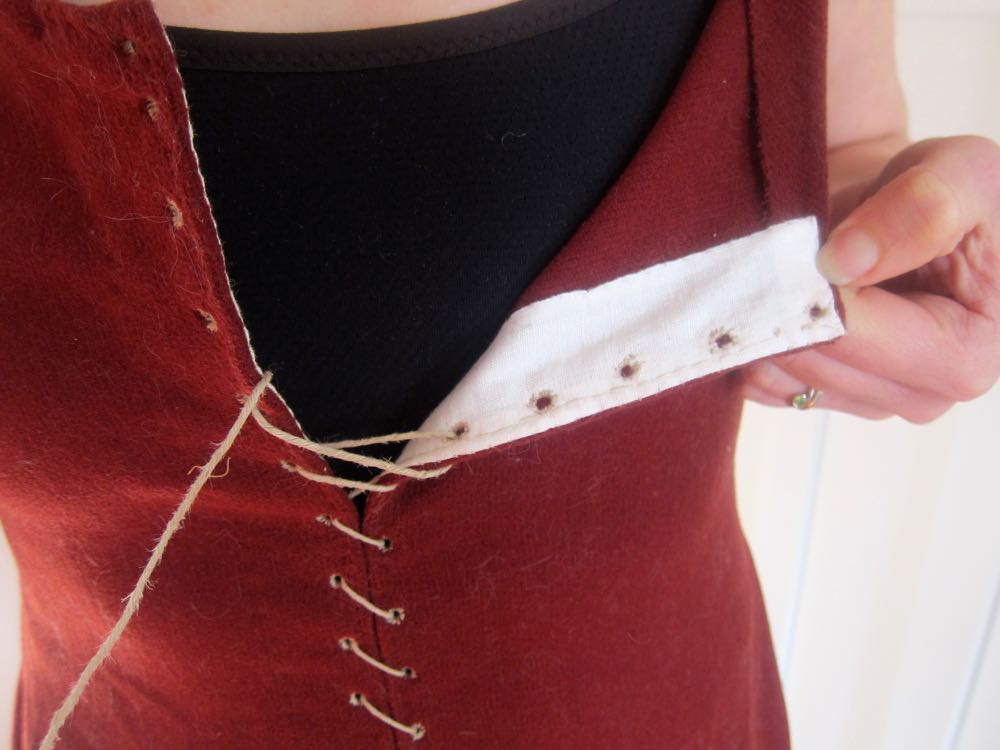
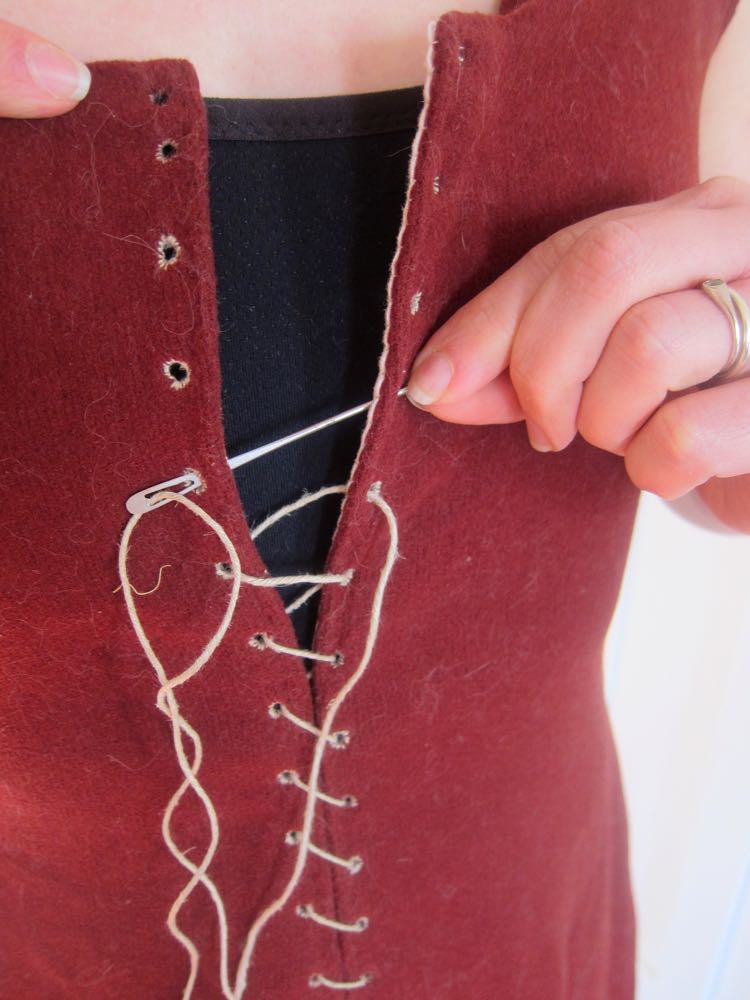
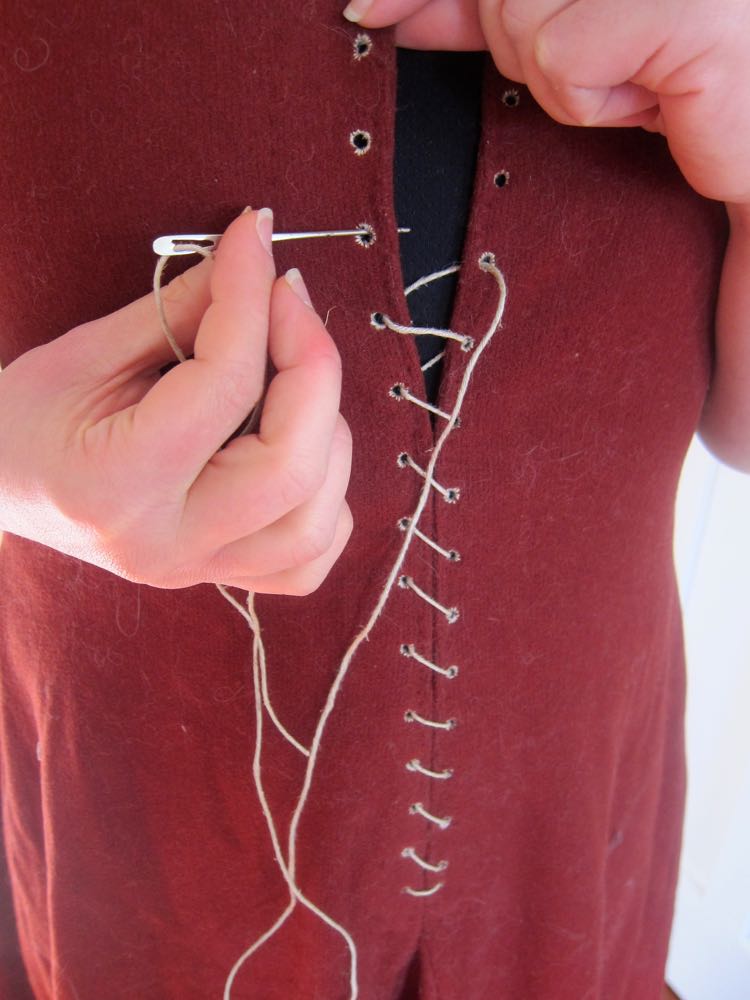
It’s looking great and I’m super-impressed with your desire to narrow down the style to a narrow decade or two and taking note of the (subtle) silhouette changes that occur. As I’ve said before, IMO far too many people consider the “cotehardie” to be a pan-European style with no differences over nearly a century (barring overdresses/accessories). Whilst generally, that is reasonably true, there are changes there and they really help make the garment look like that of the original images.
Your experiments with lining/not lining are fascinating. I’ve personally never tried a lined dress (at least on myself) but I, too, found that with a good wool you could get great bust support with no lining (and that was at a FF cup). I suspect the ‘GFD’ advice to line is based on a) the paucity of good wool in the major SCA location (i.e. U.S.A.) and b) the climate restrictions of the U.S.A. and particularly the southern states that mean that linen or very fine wool tends to be worn more often.
Good luck, and thank you for the fascinating observations!
Would the fit with the lining be appropriate for a later date, then? It does put me in mind of something, but I can’t narrow it down.
nice! it’s almost good to wear as it is now as a plain dress. handsewing does give it a much more authentic looking quality, doesn’t it?
This looks like it’s coming along great! I really loved the extreme close up of the lacing holes. it was really cool to see the handwork that closely!
vandaimages.comthemcs.orgOne big thing about lacing – they laced from top to bottom. You’ll see this in later portraits/paintings. The lacing is tied of at the top with just a bit of the end showing. It’s then laced all the way down with the excess lacing pushed into the waistline opening. This way, after eating a large meal, you could let at the bottom bit of lacing around the tummy area. (There were probably a few more reasons but that’s one of the more logical I’ve heard.) Although this is a good 50 years later, you can see the lacing dangling near the opening at the waist: http://www.vandaimages.com/results.asp?image=1106BF7074-01&itemw=2&itemf=0001&itemstep=1&itemx=3
Another later example showing the “hanging” lacing at the waistline:
https://maniacalmedievalist.files.wordpress.com/2012/11/side1.jpg
As for the direction of the lacing – you’re fine:
http://www.themcs.org/costume/Female/Germany%20Wertheim%20Stiftskirche%20Uta%20of%20Teck%201409%2083.JPG
You might be interested in this page:
http://cottesimple.com/lacing/spiral-lacing/
The thing about any assertion in historical costume that assumes everyone did something in exactly the same way is that you have to really analyse it from a practical and logical perspective. Medieval Europe was a large area, and moving between areas was slow, and sometimes dangerous. So for one method of doing things (lacing) that was not dependent on either technology, or materials, to be overwhelmingly consistent there would have to be a MASSIVE overall social or practical imperative for everyone to do it in the same way.
That’s half the reason that I have always been suspicious of the claim that lacing was always done from top to bottom.
The ‘it allowed you to ease the lacing if you had a big meal’ argument falls apart the moment you really begin to think about it. In what period of medieval history were front lacing gowns so snug around the stomach that unlacing that area would provide relief? My gown is from one of the snuggest, most androgynous, slimmest eras, AND I’ve gone out on a limb historical-accuracy wise in lowering my gussets from the waist to the hips, and yet I still have enough room around the stomach to be well past 6 months pregnant, never mind a good meal, before unlacing would do anything! The only place a medieval gown is snug is across the bust and at the high waist – certainly not across the stomach.
Now, I can think of a couple of practical reason to lace from top to bottom. Whenever you lace you have the most control to get the lace even, straight & TIGHT where you start, and any loosening over the day happens at the end, where you tie off. So if you are using the gown for bust support, you want to start at the top so that the bust stays well supported, even if the bottom loosens slightly. Lacing from the top down also gives you the advantage of securing the dress on the shoulders first (quite helpful, especially with the wider medieval necklines), so it’s not slipping off you as you lace.
However, with all of that said, and with the visual evidence that women laced down, I think there is also some visual evidence that women also laced up as well as down. How many medieval portraits show the Madonna with her gown unlaced to feed the baby Christ? She will obviously be lacing back UP for at least part of her lacing when done. Plus, lacing back up if you started lacing from the top down at the start of the day, and left no extra lacing cord, with variable bust sizing due to breast feeding, is going to be really, really annoying. From a practical sense, there would be times when women laced up.
Lacing down rather than up may have been far more common in the 11th-15th centuries, but common sense and extent evidence makes it unlikely to hold water as a blanket practice. As I tell my university students, as a researcher or historians you must pproach any ‘Always’ statements with extreme caution.
The Historical Sew Fortnightly and your blogs have been such an inspiration to me. Thank you! It is why I nominated you for the Sisterhood of The World Blogger Award in my most recent blog post. Again, thank you so very much!!
I love your blog! With regards to lacing, I think it would make a difference whether the wearer were right or left-handed. Also, there is the fact that the woman wearing this dress may have been laced in by someone else, thereby the lacing would be “opposite” what she herself would do. Or maybe none of the above, and lacing with a slant to the left meant you were married, and to the right meant unmarried? Who knows, but it is fun to think that it could have meaning.
I don’t think it makes any difference if you are right or left handed, because I can lace myself in the gown with either my right or left hands, so there is no benefit there (and being left handed was somewhat stigmatised, so people may not have wanted to advertise it). Married vs. non-married doesn’t make sense either, as few women would have had the resources to get themselves a complete new set of laced gowns upon marriage.
On looking at more examples, it seemed that the lacing slanted both ways, so it was probably much as it happened with me – up to the whim of the sewer! No hidden meaning. 🙂
I love this dress, and you’ve finally answered a question that has longed plagued me. I didn’t understand how women in the past before the introduction of the corset and then bra could be comfortable and modest yet actually have a dress that allowed them to do actual work. I wouldn’t have believed that the dress that you made would actually be supportive, but I can tell that it is, plus the comment by Panth showed me that even larger women could get good support without having to wear additional garments.
I love fashion from all eras, but I really do love the clothing from the middle ages and the Renaissance. The shoes are quite amazing, and the fabrics are pretty and comfortable in linen and wool (I prefer to purchase natural fibres whenever possible) as well as in silk and damask and other rich materials. I can’t wait to see the finished product and what headdress you wear with it.
I am left handed, and I once made a duvet cover and curtains for my bunk in college. I found some chambray and madras plaid Ralph Lauren sheets at an outlet and trimmed the chambray duvet in the madras plaid and thick cotton blanket stitching around the edges, and the curtains were cotton canvas with the madras plaid and blanket stitching. My brain wanted to do the blanket stitches in reverse, but I copied what was in the sewing book. I have to do that for crochet, embroidery, and especially in calligraphy. It’s not difficult once you get the hang of it, but I do have to adjust to doing things like playing the violin or shooting a gun like right handers do, because my brain wants to do it backwards. That’s probably a reason why left handedness was stigmatized for so long– it wasn’t considered the correct way because it went against what most people do, and we know how the church and then society viewed those who went against what “normal” people do.
I love the dress, and especially the way it fits – it just looks so *comfortable*! I’m new to your blog so I may have missed this, but what pattern did you use?
I didn’t use a pattern, but in my first post about it I show the draping process and the resulting pattern, though the end pattern is quite different to the one shown, just based on the drape of the fabric, and taking out the lining.
Draped? Oh gosh, then my hat’s off to you! My only draping experience so far is with pants, and while they fit, they are a little too tight to be comfortable. I will have to file this dress away in the “to be made” category, the next time I’m looking for a cool, off-beat sewing project.
I was surprised to see the armholes are so shallow. I’ve always been told that super-small armholes like this are uncomfortable and difficult to move about in. I have always wondered, and now that I see how well it moves in your pictures, I will have to try that also!
Thanks again, and for all the great links. 😀
Beautiful dress! Can’t wait for the final reveal. I think it also resembles the funeral effigy of Catherine of Valois, the painted one that’s missing an arm. I even thought this statue was one of your inspirations it’s so close… But now I realize that she is a different Catherine entirely by about 100 years!